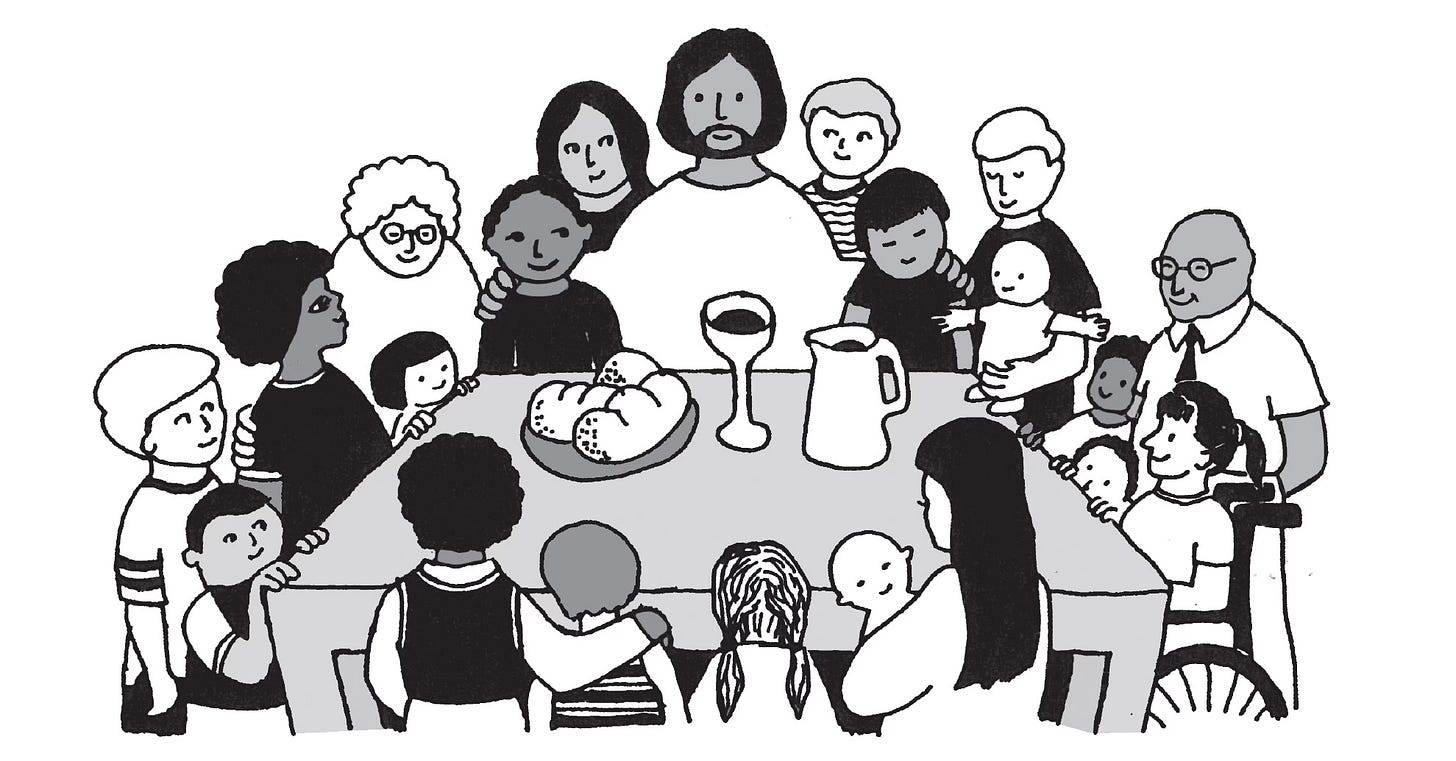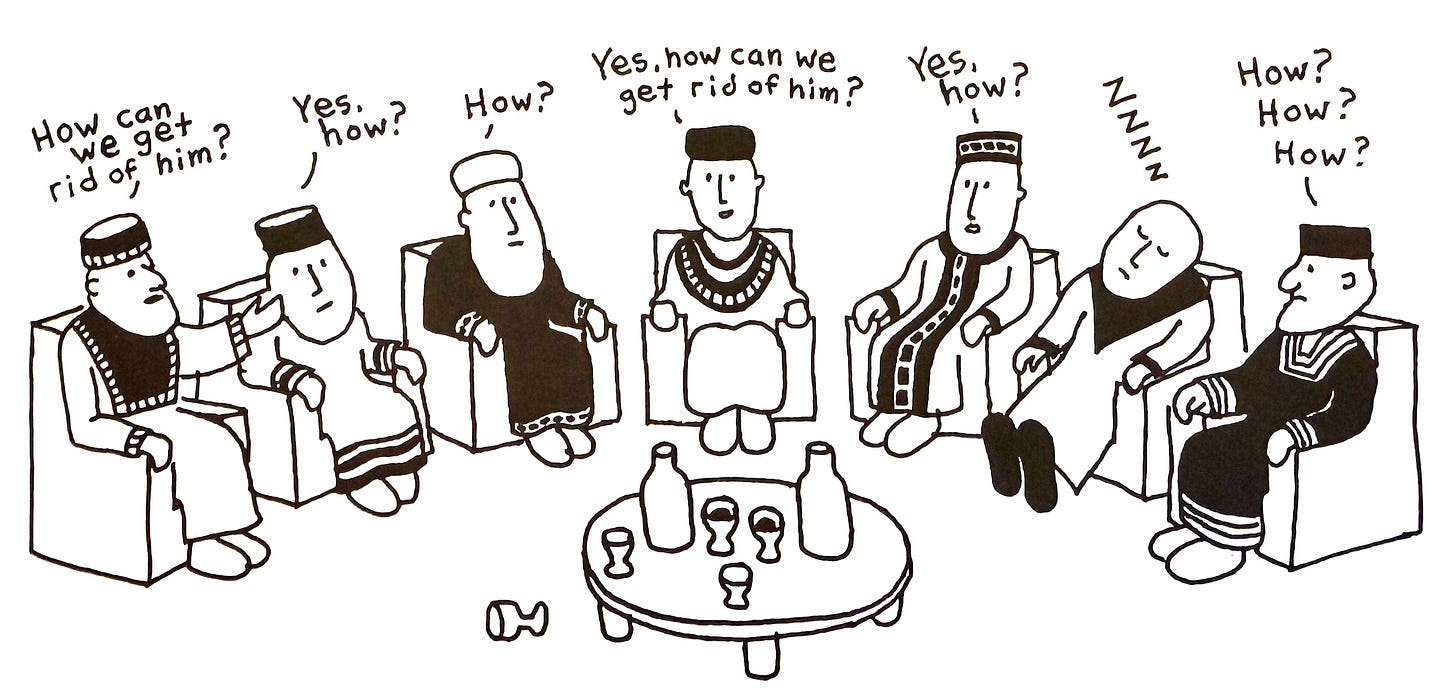Jesus in a Tuxedo T-Shirt
Reflections on Ch. 12 Jerusalem and Ch. 13 A Risen Jesus, A Risen People
Chapters 12 and 13 of Manna and Mercy cover Jesus' death and resurrection. I’ll admit, I struggle with the resurrection story—was it meant to be taken literally, or is it something bigger, something symbolic? Maybe both? Maybe neither? I’m not sure it matters. What does matter is that, while reading these chapters, I gained a new understanding of what resurrection actually might mean. And strangely enough, I couldn’t shake the image of Jesus in a tuxedo t-shirt—formal, but ready to party—because if resurrection is real (in whatever way that means), then power and success aren’t what we think they are. Maybe it’s time to rethink what Jesus' victory actually means. Let me explain…
In the movie Talladega Nights, there’s this ridiculous scene where Ricky Bobby and his family are sitting around the table, debating which version of Jesus they like best when they pray before dinner. Ricky prefers “baby Jesus” because, well, that’s his favorite. Someone else says, “I like to think of Jesus in a tuxedo t-shirt, because it says he’s formal, but he can party.” It’s a goofy movie, but that scene always cracks me up because it’s so real. Everybody has their own favorite image of Jesus—whether it’s Gentle Shepherd Jesus, Warrior Jesus, Hippie Jesus, Capitalist Jesus, or Suburban Dad Jesus. And, of course, in most American images, he’s suspiciously white.
For me? Manna and Mercy has me seeing Jesus as a counter-culture hero. Not in the trendy, rebel-without-a-cause way. But in the “this guy just flipped the whole world order on its head” way.
This Story Is About Reversal, Not Religion
We’re closing in on Jesus’ death and resurrection in Manna and Mercy. And yeah, writing about Easter a few weeks early feels a little weird—like when stores put out Christmas decorations in October. But honestly? That’s kind of the fun of doing something new for Lent.
This whole story—his arrest, crucifixion, and resurrection—is one of the most familiar in history. But if we strip away all the stained-glass church baggage, what Dan Erlander makes crystal clear in Manna and Mercy is that this is not just another religious story.
It’s a radical reversal of everything we think we know.
The last are first.
The rejected are chosen.
Death leads to life.
Weakness is ultimate strength.
This is a full-scale upheaval of power, success, and meaning—and the people in charge absolutely hate it.
Jesus Didn’t Play the Empire’s Game
The disciples wanted a powerful leader—someone to overthrow Rome, punish the wicked, and establish a righteous kin-dom.
The religious elites wanted a predictable Messiah—one who would clean up sinners, follow the rules, and not mess with their authority.
And Rome? Rome didn’t care about theology. They just wanted control.
So Jesus rolls into Jerusalem on a donkey—the ancient symbol of a ruler coming in peace, not war. It was basically the first-century equivalent of riding into a battle on a Vespa. Not exactly the military leader they were hoping for.
Instead of seizing power, Jesus starts flipping tables in the temple.Instead of calling for an uprising, he kneels down and washes feet.Instead of playing the game of empire, he lets the empire kill him.
Because Jesus isn’t here to beat the empire at its own game.He’s here to burn the whole rulebook and replace it with something better.
Jesus and the Ultimate “NOPE”
For a minute, it looks like the big deals won.
They arrested him.
They humiliated him.
They tortured him.
They crucified him.
And when he refused to fight back, they assumed they had crushed his movement for good.
But then comes the ultimate plot twist. Because God doesn’t answer with revenge—God answers with resurrection.
The empire said NOPE, this is over. God said NOPE, death isn’t the final word.
This means the resurrection isn’t just a spiritual victory—it’s a giant middle finger to the entire system of power, fear, and scarcity. It’s God’s way of saying, “You thought violence, hierarchy, and control were the ultimate reality? Watch this.”
So, What Do We Do With This?
Let’s be honest—we still benefit from the systems Jesus came to tear down.
We still chase success, status, and security.
We still build hierarchies where some people are insiders and others are outcasts.
We still play the empire’s game—even when we say we follow Jesus.
The resurrection wrecks all of that. It forces us to ask:
Do we really believe that power, wealth, and status are NOT the goal?
Are we willing to live as if the last are first?
Can we trust that there is enough manna for everyone, so we don’t have to hoard?
Because if resurrection is real, then we don’t have to play the empire’s game. We can start living like a new kind of world is possible.
Your Turn: Which Jesus Do You See?
I’ll admit, the Jesus I grew up with was mostly polite, mostly white, and mostly concerned with me being a “good person.” But Manna and Mercy keeps reminding me that the real Jesus was far more dangerous.
So here’s my question for you:
What version of Jesus were you handed?
What’s the most radical thing about Jesus that still messes with your head?
If Jesus showed up today, what modern-day temples would he start flipping tables in?
Drop your thoughts in the comments—I promise I won’t judge.
And remember: Jesus isn’t here to bless the system. He’s here to burn it down and build something better.
Are we in or not?









In these very fraught times, this message was one of new understandings ...of the deeper meaning of Resurrection...and HOPE! Thank you. and Blessings on your continued sharing.
Christine Segerhammar